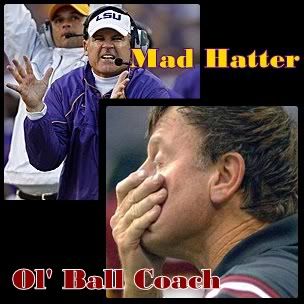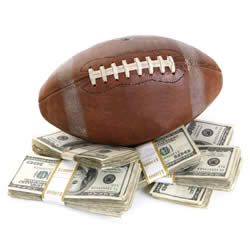But the NCAA, which has been providing us delicious scandal since January, isn't ready to give up the limelight just yet.
In light of the recent debacles at big time programs such as Oregon, LSU, Ohio State, USC, and Tennessee, fans of DI football and basketball were expecting the powers-that-be in Indianapolis to call a do-over and wipe everyone's slate clean.
Meanwhile, conferences have been getting together to propose their own solution to the escalating problems of compliance violations: paying their athletes.
Or, to be exact, increasing money given out to D1 football and basketball players to cover total cost of attendance.
The idea of paying college athletes is not new. In fact, it's a cliche and well-worn argument that has permeated the collegiate sports atmosphere almost since its inception. Keeping college athletics under the guise of amateurism, however, allows for the protection of cheap labor that generates millions in revenue for universities.
With pay, however, comes insurance and benefits complications. As one writer put it, the "administrative nightmare" would "deal a blow to the financial solar plexus of small-budget schools already straining to keep up with the Michigans, Alabamas, and Notre Dames."
While Big 12 commish Dan Beebe questions the practicality of installing a fair "cost of attendance" policy, SEC commissioner Mike Slive is all for it. As are Big 10 and C-USA commissioners Jim Delany and Brian Banowsky.
Of course (Banowsky excluded), there's a reason these fellas are eager to consider the possibility.
WVU Athletic Oliver Luck noted in a recent public address that "the reason the Big Ten and the SEC are able to recommend that is, because of their television contracts, they have the money to do that for their student athletes."
Heck, the SEC coaches make so much bank that they've taken the concept one step further.
The Ol' Ball Coach himself Steve Spurrier has put together a petition to pay his players $300 a game from his own earnings.
At an estimated $21,000 a game, times 14 games, Spurrier's $300,000 out-of-pocket plan seems like a bargain to him and others. Fellow SEC head coaches Nick Saban, Les Miles, Will Muschamp, Dan Mullen, and Derek Dooley all signed the folded, typed petition presented to the media.
 |
| These fools want to make it rain on game day |
Or is it?
I'd like to submit to you now a revision to the current NCAA amateur system which I think is genius. I wish I had come up with it, but that distinction falls to the brilliant Rick Telander, who outlined the following in his book The Hundred Yard Lie.
So....here goes (italicized text is attributed to Telander, 1996):
The Age Group Professional Football League (AGPFL)
This system would benefit those fifty to eighty big-time Division 1-A football programs, and could then likewise apply to the big-time basketball programs as well. Those receiving the benefits of this league, such as the NFL or NBA, would guarantee a partial subsidy in the form of a yearly pool for the AGPFL’s use.
- Players in the league would not have to be college students, but the league could and should use existing university facilities (stadiums, locker rooms, practice fields) when appropriate.
- These sponsoring schools would bestow the mascots and colors onto these teams.
- Players, who must be between the ages of 18-22, will receive a reasonable pay scale and will be subjected to a drug-testing program much like its professional counterpart.
- Members of the AGPFL will receive one free year of education compensation at the affiliated school for every year they play in the league if they can pass a standard entrance exam, and may redeem this offer at any time after they play in the league (or during, although the demands of playing would probably be too much combined with education courses).
Abolishing amateurism at the top tier of college athletics does not mean that every college athlete should be paid, however. Schools that wish to not buy into this program may retain their “college teams”. These teams will be under new guidelines as truly “amateur” athletic atmospheres.
- College teams that have an AGPFL may not also have a college team in that sport, nor can they charge admission or use it as a money-making event.
- College seasons must be only eight games long, and may have a single- game championship, but must limit their season to after Labor Day and before Christmas.
- Practices must be limited to five, ninety-minute practices a week, and may not extend after the playing season is done or before it starts in the new school year.
- College coaching staffs must be limited to four members, and all of those members must have other university teaching duties.
- Finally, there will be no scholarships available to college athletes that are not also available to every other student in the university, and coaches will not be allowed to make money off of TV, radio, or other endorsement deals
Because of the clear separation of amateur and professional programs, the benefits to the new system will be numerous. There will no longer be need for recruiting violations and underhanded dealings, because the AGPFL players will be receiving fair monetary compensation for their work, as well as insurance and workmen’s compensation.
There will also be no need for academic fraud, since there will be no academic standards for the big-time players of the AGPFL. Conversely, college athletes will not be the highly recruited athletes, so there will be no incentive to pay them or give them breaks in the classroom.
If an athlete in the AGPFL finds he does not wish to pursue big-time athletics, he may drop out and apply to college, and those who do choose to use their free years of education will find it of better use than the system now, where athletics and academics are in competition for the athlete’s time and energy. Although schools may decide to either become an AGPFL team from a college team, or vice versa, there will have to be time limits of five years in between changes to prevent teams from taking advantage of team strengths or weaknesses.
Maybe Rick Telander and I are on the same planet filled with rainbows and unicorns, but I personally love the above solution. Is it something I can see passing any time in the near future? No.
But let's be real....bureaucrats love their red tape and complicated systems. Maybe pay for play has no business in college athletics.
Let's hope one day logic does.
*****************************************************************
So college sports fans...let me know what ya'll think. Are you one of the touted "amateur all-the-way" fanatics? Do you, like me, think Rick Telander is a genius? Do you wish there really WAS a planet filled with unicorns and rainbows?
Hit me up and let me know!
Images provided by otbsonline, blogcdn, deadspin, and thumbs3.ebaystatic.










1 comments:
I'll stick to "amateur all the way" status. I still have a $15k+ student loan that says athletes get paid.
My rainbow-covered unicorn thingy would consist of 2 steps:
(1) Have the NCAA create competitive leagues for the major sports. Obviously, there won't be college affiliations, but there could still be regional affiliations to make it interesting. Pay these players some kind of flat rate, say $15k/season.
(2) Student-Athletes play college sports, but raise the academic standards for players to truly make them student-athletes.
Post a Comment